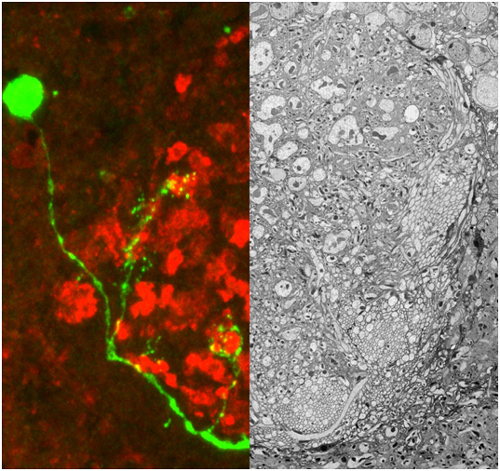Time:2013-07-05
On Jul 1, 2013, Dr. Aike Guoa€?s research group at the Institute of Neuroscience, Chinese Academy of Sciences published a research report online entitled "Transformation of odor selectivity from projection neurons to single mushroom body neurons mapped with dual-color calcium imaging" in the journal PNAS.
Neurons exhibit a wide variety of response properties that reflect their functions in the brain. For example, it has been reported that certain neurons in the human hippocampus were specifically activated by the American actress Jennifer Aniston. How neurons acquire such specific response properties is a central question in understanding of the brain. As a typical neuron is an integration device that converts input signals from many presynaptic neurons into a single output signal, its response properties are necessarily computed from the response properties of the presynaptic inputs. Ideally, one should first determine the response properties of a neuron of interest, and then map one by one the response properties of all the presynaptic inputs to the neuron. However, such a strategy has been difficult to implement because of the immense structural complexity of the nervous system.
Here, a new strategy was introduced in this work towards understanding this problem. Using the Drosophila mushroom body as a model system, the authors labeled single Kenyon cells (KCs) with the green calcium indicator protein G-CaMP, and densely labeled the presynaptic projection neurons (PNs) with the red calcium indicator protein R-GECO. The odor evoked response properties of the single KC and the population of PN axon terminals were then simultaneously measured with dual-color calcium imaging. Afterwards, the PN axon terminals that make synaptic contacts with the single KC were determined with structural mapping, allowing an analysis of how odor evoked response properties were transformed from the PN inputs to the single KC.
Using this strategy, the authors found that the output of single KCs could be well predicted by a linear summation of the PN input signals, indicating that excitatory PN inputs play the major role in generating odor-selective responses in KCs. When odors failed to activate KC output, local calcium transients restricted to individual postsynaptic sites could be observed in the KC dendrites. The response amplitudes of the local transients often correlated linearly with the presynaptic response amplitudes, allowing direct assay of the strength of single synaptic sites. Furthermore, the authors found a scaling relationship between the average synaptic strength of the PN terminals and the total number of PN terminals a single KC received.
The strategy introduced in this work provides a unique perspective on the process of information transmission and integration in a model neural circuit, and may be broadly applicable for the study of the origin of neuronal response properties.
This work was carried out by graduate students Hao Li, Yiming Li, Zhengchang Lei and Kaiyu Wang under the supervision of Dr. Aike Guo. The study was completed at the Institute of Neuroscience and State Key Laboratory of Neuroscience, Shanghai Institutes for Biological Sciences, Chinese Academy of Sciences, and supported by the 973 Program, the Natural Science Foundation of China, and the Strategic Priority Research Program of the Chinese Academy of Sciences.

Image: A single KC receiving inputs from several PN axon terminals.
 附件下载:
附件下载: